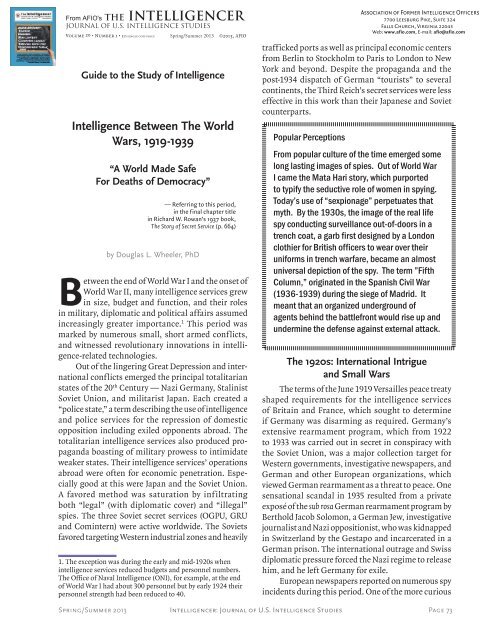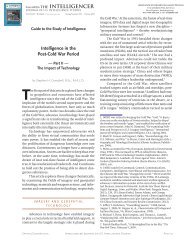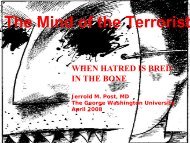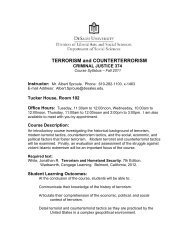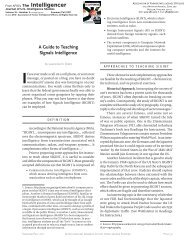Intelligence Between the World Wars, 1919-1939 - A World Made ...
Intelligence Between the World Wars, 1919-1939 - A World Made ...
Intelligence Between the World Wars, 1919-1939 - A World Made ...
Create successful ePaper yourself
Turn your PDF publications into a flip-book with our unique Google optimized e-Paper software.
From AFIO's The <strong>Intelligence</strong>r<br />
Journal of U.S. <strong>Intelligence</strong> Studies<br />
Volume 20 • Number 1 • $15 single copy price<br />
Spring/Summer 2013<br />
Guide to <strong>the</strong> Study of <strong>Intelligence</strong><br />
<strong>Intelligence</strong> <strong>Between</strong> The <strong>World</strong><br />
<strong>Wars</strong>, <strong>1919</strong>-<strong>1939</strong><br />
“A <strong>World</strong> <strong>Made</strong> Safe<br />
For Deaths of Democracy”<br />
— Referring to this period,<br />
in <strong>the</strong> final chapter title<br />
in Richard W. Rowan’s 1937 book,<br />
The Story of Secret Service (p. 664)<br />
by Douglas L. Wheeler, PhD<br />
©2013, AFIO<br />
<strong>Between</strong> <strong>the</strong> end of <strong>World</strong> War I and <strong>the</strong> onset of<br />
<strong>World</strong> War II, many intelligence services grew<br />
in size, budget and function, and <strong>the</strong>ir roles<br />
in military, diplomatic and political affairs assumed<br />
increasingly greater importance. 1 This period was<br />
marked by numerous small, short armed conflicts,<br />
and witnessed revolutionary innovations in intelligence-related<br />
technologies.<br />
Out of <strong>the</strong> lingering Great Depression and international<br />
conflicts emerged <strong>the</strong> principal totalitarian<br />
states of <strong>the</strong> 20 th Century — Nazi Germany, Stalinist<br />
Soviet Union, and militarist Japan. Each created a<br />
“police state,” a term describing <strong>the</strong> use of intelligence<br />
and police services for <strong>the</strong> repression of domestic<br />
opposition including exiled opponents abroad. The<br />
totalitarian intelligence services also produced propaganda<br />
boasting of military prowess to intimidate<br />
weaker states. Their intelligence services’ operations<br />
abroad were often for economic penetration. Especially<br />
good at this were Japan and <strong>the</strong> Soviet Union.<br />
A favored method was saturation by infiltrating<br />
both “legal” (with diplomatic cover) and “illegal”<br />
spies. The three Soviet secret services (OGPU, GRU<br />
and Comintern) were active worldwide. The Soviets<br />
favored targeting Western industrial zones and heavily<br />
1. The exception was during <strong>the</strong> early and mid-1920s when<br />
intelligence services reduced budgets and personnel numbers.<br />
The Office of Naval <strong>Intelligence</strong> (ONI), for example, at <strong>the</strong> end<br />
of <strong>World</strong> War I had about 300 personnel but by early 1924 <strong>the</strong>ir<br />
personnel strength had been reduced to 40.<br />
trafficked ports as well as principal economic centers<br />
from Berlin to Stockholm to Paris to London to New<br />
York and beyond. Despite <strong>the</strong> propaganda and <strong>the</strong><br />
post-1934 dispatch of German “tourists” to several<br />
continents, <strong>the</strong> Third Reich’s secret services were less<br />
effective in this work than <strong>the</strong>ir Japanese and Soviet<br />
counterparts.<br />
Popular Perceptions<br />
Association of Former <strong>Intelligence</strong> Officers<br />
7700 Leesburg Pike, Suite 324<br />
Falls Church, Virginia 22043<br />
Web: www.afio.com , E-mail: afio@afio.com<br />
From popular culture of <strong>the</strong> time emerged some<br />
long lasting images of spies. Out of <strong>World</strong> War<br />
I came <strong>the</strong> Mata Hari story, which purported<br />
to typify <strong>the</strong> seductive role of women in spying.<br />
Today’s use of “sexpionage” perpetuates that<br />
myth. By <strong>the</strong> 1930s, <strong>the</strong> image of <strong>the</strong> real life<br />
spy conducting surveillance out-of-doors in a<br />
trench coat, a garb first designed by a London<br />
clothier for British officers to wear over <strong>the</strong>ir<br />
uniforms in trench warfare, became an almost<br />
universal depiction of <strong>the</strong> spy. The term ”Fifth<br />
Column,” originated in <strong>the</strong> Spanish Civil War<br />
(1936-<strong>1939</strong>) during <strong>the</strong> siege of Madrid. It<br />
meant that an organized underground of<br />
agents behind <strong>the</strong> battlefront would rise up and<br />
undermine <strong>the</strong> defense against external attack.<br />
The 1920s: International Intrigue<br />
and Small <strong>Wars</strong><br />
The terms of <strong>the</strong> June <strong>1919</strong> Versailles peace treaty<br />
shaped requirements for <strong>the</strong> intelligence services<br />
of Britain and France, which sought to determine<br />
if Germany was disarming as required. Germany’s<br />
extensive rearmament program, which from 1922<br />
to 1933 was carried out in secret in conspiracy with<br />
<strong>the</strong> Soviet Union, was a major collection target for<br />
Western governments, investigative newspapers, and<br />
German and o<strong>the</strong>r European organizations, which<br />
viewed German rearmament as a threat to peace. One<br />
sensational scandal in 1935 resulted from a private<br />
exposé of <strong>the</strong> sub rosa German rearmament program by<br />
Berthold Jacob Solomon, a German Jew, investigative<br />
journalist and Nazi oppositionist, who was kidnapped<br />
in Switzerland by <strong>the</strong> Gestapo and incarcerated in a<br />
German prison. The international outrage and Swiss<br />
diplomatic pressure forced <strong>the</strong> Nazi regime to release<br />
him, and he left Germany for exile.<br />
European newspapers reported on numerous spy<br />
incidents during this period. One of <strong>the</strong> more curious<br />
Spring/Summer 2013<br />
<strong>Intelligence</strong>r: Journal of U.S. <strong>Intelligence</strong> Studies<br />
Page 73
Conflicts in <strong>the</strong> Inter-war Period (<strong>1919</strong>-<strong>1939</strong>)<br />
Europe<br />
1917-1921 Ukrainian War of Independence<br />
1918-1921 Russian Civil War (Bolsheviks)<br />
1918-1920 Latvian War of Independence<br />
1918-1920 Hungarian – Romanian War<br />
<strong>1919</strong>-1921 Anglo-Irish War<br />
<strong>1919</strong> Estonian War of Independence<br />
<strong>1919</strong>-1920 Lithuanian War of Independence<br />
<strong>1919</strong> Czechoslovak-Polish War<br />
1920 Russo-Polish War<br />
1920 Vlora War (Italy-Albania)<br />
1920 Polish-Lithuanian War<br />
1934 Austrian Civil Strife<br />
1936-<strong>1939</strong> Spanish Civil War<br />
<strong>1939</strong> Slovak-Hungarian War<br />
Middle East<br />
<strong>1919</strong>-1922 Turkish War of Independence<br />
<strong>1919</strong>-1922 Greco-Turkish War<br />
1920-1921 Franco-Turkish War (Cilicia)<br />
1920 Iraqi Revolt/War<br />
1926-1928 French suppression of Syrian Revolt<br />
1936-<strong>1939</strong> British Palestine sectarian strife<br />
Africa<br />
1920-1927 Franco-Spanish pacification of Morocco<br />
1922 South African pacification of SW Africa<br />
1925-1935 Italian aggression in Libya<br />
1930 Gugsa Welle’s rebellion, Ethiopia<br />
1935-1936 Italo-Ethiopian War<br />
Asia<br />
<strong>1919</strong> 3 rd Anglo-Afghan War (NW frontier)<br />
1920s<br />
British pacification of Burma, India<br />
1927-1937 Chinese Civil War<br />
1931 Japanese invasion of Manchuria<br />
1932 Japanese attack on Shanghai<br />
1937-1945 Sino-Japanese War<br />
<strong>1939</strong> Russo-Japanese Border War<br />
(Outer Mongolia)<br />
Latin America<br />
1920-1935 US interventions – Nicaragua, Haiti,<br />
Dominican Republic, and Honduras<br />
1927-1929 Mexican Cristero War<br />
1932-1935 Chaco War (Bolivia – Paraguay)<br />
cases involved Polish Major Jerzy Sosnowski, who<br />
in 1926 was sent to Berlin to uncover <strong>the</strong> plans and<br />
intentions of <strong>the</strong> post-war Weimar Republic. With<br />
a well-funded cover as a wealthy, aristocratic Polish<br />
war hero, playboy, racehorse owner and businessman,<br />
Sosnowski built a spy ring, which penetrated<br />
Germany’s War Ministry. He was arrested in Berlin<br />
in 1934 and put on trial as a spy. Several of <strong>the</strong> aristocratic<br />
German women spies he had recruited, who<br />
were also his lovers, were also put on trial. Unlike<br />
Sosnowski, who was released and returned to<br />
Poland as part of a German-Polish spy exchange, <strong>the</strong><br />
women were executed by beheading. Upon his return<br />
to Poland, Sosnowski was arrested and accused of<br />
having been “turned” by Germany and was given a<br />
fifteen-year prison sentence. The twists and turns<br />
of <strong>the</strong> Sosnowski case illustrate <strong>the</strong> extent to which<br />
deception had become a common practice in <strong>the</strong><br />
European espionage wars.<br />
The end of <strong>World</strong> War I and <strong>the</strong> peace settlements<br />
did not bring an end to conflict in Europe or<br />
elsewhere. Numerous conflicts ensued —wars of<br />
independence, nationalist resistance to European<br />
colonialism, frontier readjustments of <strong>the</strong> new Eastern<br />
European states created in <strong>the</strong> aftermath of <strong>the</strong><br />
peace treaties, brutal civil wars in Russia and Spain,<br />
and territorial aggression by Japan and Italy in Asia<br />
and Africa. Consequently, <strong>the</strong> intelligence services<br />
of <strong>the</strong> European states were busy.<br />
For more than half of <strong>the</strong> interwar period,<br />
British and French intelligence services focused on<br />
<strong>the</strong> emerging Soviet Union, which despite its efforts<br />
to foster Communist revolutions ei<strong>the</strong>r by invading<br />
a neighbor (Poland, 1920) or by fomenting internal<br />
uprisings of Communist workers, sailors and soldiers<br />
(Germany, Hungary, and Austria), remained<br />
<strong>the</strong> only country which practiced Communism.<br />
After <strong>the</strong> Russian civil war ended in 1920-21 with<br />
<strong>the</strong> Bolshevik victory, a secret war proceeded, which<br />
pitted <strong>the</strong> British and French secret services against<br />
<strong>the</strong> expanding services of <strong>the</strong> Soviet Union. From <strong>the</strong><br />
Bolshevik’s initial secret police, <strong>the</strong> CHEKA, grew a<br />
larger service with various acronyms such as OGPU<br />
and NKVD. Even though OGPU, for example, dominated<br />
<strong>the</strong> intelligence field and was much larger and<br />
better funded, it was not <strong>the</strong> sole secret service: <strong>the</strong>re<br />
was also Soviet military intelligence, <strong>the</strong> GRU, as<br />
well as departments of <strong>the</strong> Communist International<br />
(Comintern), which employed agents at home and<br />
abroad. 2 The Soviet Union remained diplomatically<br />
2. For a history of Soviet and Russian secret services see Robert<br />
Page 74 <strong>Intelligence</strong>r: Journal of U.S. <strong>Intelligence</strong> Studies Spring/Summer 2013
isolated throughout much of <strong>the</strong> 1920s. It was not recognized<br />
diplomatically until <strong>the</strong> late 1920s (and not<br />
until 1933 by <strong>the</strong> United States) and did not join <strong>the</strong><br />
League of Nations until 1934. Its foreign and defense<br />
policies functioned with <strong>the</strong> presumption that <strong>the</strong><br />
main Western capitalist states, which had worked to<br />
defeat <strong>the</strong> Bolsheviks, remained hostile.<br />
Soviet intelligence services sought to discover <strong>the</strong><br />
military plans and intentions of adversaries such as<br />
Britain, France, Germany, and <strong>the</strong> United States, as<br />
well as Japan to which it had lost <strong>the</strong> 1904 Russo-Japanese<br />
War and continued to have territorial disputes in<br />
<strong>the</strong> Far East. In addition Soviet spies sought to obtain<br />
Western industrial and economic secrets in order to<br />
industrialize and compete with Western powers and<br />
streng<strong>the</strong>n <strong>the</strong> Soviet armed forces.<br />
The Soviets employed different types of spies:<br />
“legals,” who used diplomatic cover at Soviet consulates<br />
and embassies and “illegals,” who used all<br />
manner of cover, including Soviet press and trade<br />
associations established in foreign capitals, as well<br />
as a variety of philosophically sympa<strong>the</strong>tic agents<br />
who infiltrated workers’ unions, defense industries,<br />
and merchant marine crews. The targeting of workers<br />
and merchant seamen in major ports in Germany, <strong>the</strong><br />
Low Countries and Scandanavia had <strong>the</strong> dual purpose<br />
of encouraging <strong>the</strong> overthrow of capitalism through<br />
paralyzing strikes and sabotage in <strong>the</strong> event of war<br />
with <strong>the</strong> Soviet Union.<br />
Stalin used <strong>the</strong> long arm of Soviet intelligence to<br />
neutralize and murder exiled White Russians (<strong>the</strong> side<br />
which lost <strong>the</strong> Russian Civil War) and o<strong>the</strong>r enemies of<br />
<strong>the</strong> USSR wherever <strong>the</strong>y resided abroad. Such tactics<br />
became public knowledge in Paris, a major sanctuary<br />
for thousands of White Russians, after <strong>1919</strong> when<br />
newspapers wrote stories about opponents or defectors<br />
being kidnapped from Paris streets or murdered<br />
in Switzerland. Most famously, Stalin’s principal rival,<br />
Leon Trotsky, was exiled in 1929 and assassinated in<br />
Mexico in 1940 by a Soviet agent recruited and trained<br />
by <strong>the</strong> NKVD during <strong>the</strong> Spanish Civil War (1936-39).<br />
Two intelligence-related technologies, which<br />
were new in <strong>World</strong> War I, were fur<strong>the</strong>r developed in<br />
<strong>the</strong> 1920s: signals intelligence, which grew out of <strong>the</strong><br />
contest between cryptography and cryptanalysis with<br />
<strong>the</strong> use of two-way radios in addition to telegraphy<br />
and photography, used from airplanes to locate enemy<br />
forces and weaponry. Various intelligence services<br />
W. Pringle, “Guide to Soviet and Russian <strong>Intelligence</strong> Services,”<br />
<strong>Intelligence</strong>r, Vol. 18, No. 2, Winter/Spring 2011, pp 51 – 54. Also<br />
on-line at www.afio.com/guide.<br />
throughout <strong>the</strong> world tried to exploit <strong>the</strong> protected<br />
communications of o<strong>the</strong>r states. 3 Germany introduced<br />
a sophisticated cryptographic machine in <strong>the</strong> 1920s<br />
called “Enigma.” Polish and French code-breakers<br />
began to solve Enigma codes, which became a key<br />
advantage for Allied intelligence in <strong>World</strong> War II.<br />
In addition, spies and counter-intelligence agents<br />
employed concealable cameras with which to photograph<br />
purloined documents as well as industrial and<br />
military equipment. Fur<strong>the</strong>rmore, secret agents could<br />
now use portable equipment for recording voices without<br />
<strong>the</strong> subjects’ knowledge or for tapping telephone<br />
lines. These technologies became common tools in<br />
future international secret wars although even major<br />
powers could not always afford to equip <strong>the</strong>ir agents<br />
with such devices. As of September <strong>1939</strong>, for example,<br />
Britain’s spies abroad still did not have two-way radios.<br />
In <strong>the</strong> 1920s US intelligence focus was largely<br />
domestic. The anarchist and communist threats at<br />
home were <strong>the</strong> principal focus. Foreign intelligence<br />
collection was accomplished by a limited number of<br />
military and naval attaches posted in selected European<br />
and Asian countries. However, <strong>the</strong> US developed<br />
a significant signals intelligence capacity between <strong>the</strong><br />
wars, despite setbacks and modest budgets. When<br />
<strong>World</strong> War I ended, Department of State codebreaking<br />
pioneer, Herbert O. Yardley, moved <strong>the</strong> Cipher Bureau,<br />
commonly known as <strong>the</strong> “Black Chamber,” to New<br />
York City and was financed by <strong>the</strong> Department of State<br />
and <strong>the</strong> Navy. In 1921, at <strong>the</strong> Washington Naval Arms<br />
Limitation Treaty conference, Yardley’s reading of <strong>the</strong><br />
Japanese delegates’ secret diplomatic messages gave<br />
an advantage to American diplomats and enabled <strong>the</strong><br />
United States to constrain Japan’s naval construction<br />
allowance in <strong>the</strong> final treaty. But in 1929, Secretary of<br />
State Stimson shut down Yardley’s New York signal<br />
intelligence unit with <strong>the</strong> now legendary comment,<br />
“Gentlemen do not read each o<strong>the</strong>r’s mail.” That same<br />
year, never<strong>the</strong>less, <strong>the</strong> U.S. Army Signal <strong>Intelligence</strong><br />
Service was established and used Yardley’s unit’s old<br />
files. SIS was headed by codebreaking genius, William<br />
Friedman, who by <strong>1939</strong>-1940 had achieved successes<br />
in reading high level diplomatic traffic from <strong>the</strong> new<br />
Japanese encoding “Red” machine. Meanwhile, in<br />
1924, <strong>the</strong> U.S. Navy established a code-breaking unit<br />
in <strong>the</strong> Office of Naval <strong>Intelligence</strong> and began to work<br />
on Japanese diplomatic and naval traffic. In signals<br />
intelligence <strong>the</strong>re was competition between <strong>the</strong> Army<br />
and Navy units.<br />
3. Some success against British naval signals was enjoyed by<br />
Germany between <strong>the</strong> wars.<br />
Spring/Summer 2013<br />
<strong>Intelligence</strong>r: Journal of U.S. <strong>Intelligence</strong> Studies<br />
Page 75
The 1930s: The Not-So-Secret March<br />
to <strong>World</strong> War II<br />
The totalitarian states built-up <strong>the</strong>ir secret intelligence<br />
services during <strong>the</strong> 1930s. Nazi Germany and<br />
Japan, in particular, initiated aggressive subversion<br />
on an unprecedented scale. Japanese intelligence<br />
played an active role in <strong>the</strong> territorial expansion into<br />
Manchuria (1931) and mainland China (1937), which<br />
marked <strong>the</strong> beginning of <strong>World</strong> War II in <strong>the</strong> Far East.<br />
Japan’s services conducted subversion, deception and<br />
provocations in order to justify military intervention.<br />
While Italy’s takeover of Libya and conquest<br />
of Ethiopia (Abyssinia, 1935-36), were sideshows,<br />
<strong>the</strong> Spanish Civil War (1936-39), which began as a<br />
domestic conflict and caused at least 600,000 deaths<br />
and uncounted injuries and destruction, is viewed<br />
by many historians as <strong>the</strong> prelude and rehearsal for<br />
<strong>World</strong> War II in Europe. The Soviet Union supported<br />
<strong>the</strong> loyalists of <strong>the</strong> Spanish Republic, while <strong>the</strong> Fascist<br />
powers, Germany and Italy, supported General Franco’s<br />
Nationalists. One legacy was <strong>the</strong> Soviet enlistment<br />
of Spanish spies, saboteurs, and assassins who, after<br />
<strong>the</strong> Republic fell, participated in <strong>the</strong> underground<br />
activities of Stalin, including infiltrating various<br />
countries and carrying out revenge missions abroad.<br />
One of <strong>the</strong> most talented secret agents of all was<br />
Richard Sorge, a spy for Soviet military intelligence<br />
(GRU) who served in <strong>the</strong> Far East. Sorge was in China<br />
and <strong>the</strong>n Japan with <strong>the</strong> cover of a newspaper reporter.<br />
His principal mission was to discover Japan’s plans<br />
toward <strong>the</strong> Soviet Union, but by posing as a German<br />
and gaining access to <strong>the</strong> German embassy in Tokyo<br />
he also collected information on <strong>the</strong> Third Reich’s<br />
strength, plans and intentions. Sorge’s fa<strong>the</strong>r was<br />
German, his mo<strong>the</strong>r Russian. His warning of Germany’s<br />
intentions appear to have been ignored by<br />
Stalin but his intelligence on Japan’s intention not to<br />
invade <strong>the</strong> Soviet Far East allowed Stalin to reposition<br />
significant forces from Siberia to face west.<br />
In <strong>the</strong> 1930s <strong>the</strong> number of arrests of spies and<br />
spy trials rapidly grew in Europe. Typically, spy scares<br />
heightened concerns about security and trials stirred<br />
patriotic feelings. After 1930 in most states espionage<br />
during peacetime could result in capital punishment.<br />
By <strong>the</strong> time <strong>World</strong> War II began with <strong>the</strong> German<br />
invasion of Poland on September 1, <strong>1939</strong>, most of<br />
<strong>the</strong> intelligence services were far larger and better<br />
equipped than <strong>the</strong>y had been in 1914. However, assessments<br />
of potential enemies in <strong>the</strong> late 1930s were often<br />
wide of <strong>the</strong> mark. Assessments of many states were<br />
more accurate in terms of counting numbers of enemy<br />
Hitler, Mussolini, and Stalin were Spies<br />
Hitler, Mussolini and Stalin each had minor<br />
intelligence service credentials. Though <strong>the</strong>y<br />
were but tiny cogs in <strong>the</strong> intelligence wheel,<br />
<strong>the</strong>y were participants: Hitler was a spy and<br />
propagandist for <strong>the</strong> German army in <strong>the</strong><br />
early years of <strong>the</strong> ill-fated Weimar Republic;<br />
Mussolini late in <strong>World</strong> War I acted as a<br />
French secret agent, and Stalin before <strong>the</strong><br />
1917 Revolution had been an informant in<br />
Czarist Russia’s secret police, <strong>the</strong> Okhrana.<br />
forces and resources, but less accurate in plotting<br />
plans and intentions. Britain’s intelligence system<br />
overestimated Nazi Germany’s air force strength by<br />
almost 50%, yet came closer in estimating ground<br />
forces’ numbers, if not <strong>the</strong>ir military prowess.<br />
In <strong>the</strong> US <strong>the</strong> Justice Department’s Federal Bureau<br />
of Investigation, beginning in 1936, was given presidential<br />
authority to devote greater resources against<br />
subversives, including foreign spies, especially Nazi<br />
and Japanese agents and, to a lesser extent, Soviet<br />
spies. With <strong>the</strong> outbreak of war in Europe in September<br />
<strong>1939</strong>, <strong>the</strong> intelligence efforts of <strong>the</strong> Army, Navy and<br />
FBI began to grow rapidly.<br />
READINGS FOR INSTRUCTORS<br />
No comprehensive intelligence history exists of<br />
<strong>the</strong> period between <strong>the</strong> world wars. Most coverage is<br />
by individual country or regime.<br />
Great Britain<br />
For an introduction to British<br />
intelligence after 1918, <strong>the</strong>re is<br />
Christopher Andrew’s, Her Majesty’s<br />
Secret Service (originally published<br />
in 1984, updated in paperback<br />
in 1998<br />
by Viking), but<br />
it should be<br />
noted that in <strong>the</strong> late 1990s official<br />
histories of MI-6 and MI-5 were<br />
published and include materials<br />
that cover this era. See Keith Jeffery,<br />
The Secret History of MI6, 1909-<br />
1949 (New York, Penguin, 2010),<br />
Page 76 <strong>Intelligence</strong>r: Journal of U.S. <strong>Intelligence</strong> Studies Spring/Summer 2013
and Christopher Andrew, Defend<br />
The Realm. The Authorized History of<br />
MI5 (New York, Knopf, 2009).<br />
France<br />
For spies, international crime<br />
and intrigue in interwar France,<br />
Michael Miller’s<br />
Shanghai on <strong>the</strong> Métro (1994, Berkeley,<br />
University of California Press)<br />
utilizes police files and popular spy<br />
literature. For a larger perspective on<br />
France’s intelligence history, Douglas<br />
Porch’s The French Secret Services (1995,<br />
New York, Farrar, Straus, Giroux)<br />
remains indispensable. The classic anthology related<br />
to intelligence assessments in <strong>the</strong> 1920s and 1930s (as<br />
well as pre-1914) in Britain, Germany, Russia, France,<br />
Italy, Japan and <strong>the</strong> United States, is Ernest R. May (ed),<br />
Knowing One’s<br />
Enemies (1984,<br />
Princeton, NJ,<br />
Princeton University<br />
Press)<br />
based in large<br />
part on government<br />
archives.<br />
USSR<br />
Studies of Soviet intelligence<br />
to <strong>1939</strong> represent a field unto<br />
itself and includes biographies<br />
and autobiographies of spies, early<br />
Soviet defectors and underground<br />
agents. A good biography of master<br />
spy, Richard<br />
Sorge, is Robert<br />
Whymant, Stalin’s Spy (1998, New<br />
York, St. Martin’s Press). A classic<br />
anatomy of Soviet spying into<br />
<strong>the</strong> early Cold War<br />
years by a Russian-born<br />
historian<br />
is David<br />
Dallin’s Soviet Espionage (1955, New<br />
Haven, CT, Yale University Press).<br />
Biographies of early Soviet defectors,<br />
several of whom were intelligence<br />
officers, are in Gordon Brook-Shepherd, The Storm<br />
Petrels (1978, Ballantine books).<br />
Japan<br />
For information on pre-1940 Japanese intelligence<br />
(besides a chapter in Ernest May’s book cited<br />
above), see <strong>the</strong> chapter by J.W.M. Chapman, “Japanese<br />
<strong>Intelligence</strong>, 1918-1945: A Suitable Case for Treatment,”<br />
in Christopher Andrew and James Noakes (eds),<br />
<strong>Intelligence</strong> and International Relations (1900-1945) (1987,<br />
Exeter UK: Exeter University Publications).<br />
America<br />
Useful material on American intelligence services<br />
between <strong>the</strong> world wars is in an archive-based study<br />
by Robert G. Angevin, “Gentlemen<br />
Do Read Each O<strong>the</strong>r’s<br />
Mail: American <strong>Intelligence</strong> in<br />
<strong>the</strong> Interwar Era,” <strong>Intelligence</strong> and<br />
National Security ( Vol.7, No.2,<br />
1992, pp. 1-29). And G.J.A.<br />
O’Toole’s general survey of<br />
American intelligence history<br />
has useful chapters (25-29) on<br />
1918 to <strong>1939</strong>: Honorable Treachery<br />
(1991, Atlantic Monthly Press). The Office of <strong>the</strong><br />
National Counterintelligence Executive has posted on<br />
its website a loosely edited but interesting and detailed<br />
history of US counterintelligence. See http://www.ncix.<br />
gov/publications/ci_references/index.php.<br />
Douglas L. Wheeler is Professor<br />
of History Emeritus, University<br />
of New Hampshire and a previous<br />
contributor to <strong>the</strong> Guide to<br />
<strong>the</strong> Study of <strong>Intelligence</strong>. See his<br />
articles “A Guide to <strong>the</strong> History<br />
of <strong>Intelligence</strong> in <strong>the</strong> Age of<br />
Empires, 1500-1800,” <strong>Intelligence</strong>r,<br />
Vol. 18, No. 3, Summer/Fall 2011; “A Guide to<br />
<strong>the</strong> History of <strong>Intelligence</strong>, 1800-1918,” <strong>Intelligence</strong>r,<br />
Vol, 19, No. 1, and “A Note About <strong>Intelligence</strong> Historiography,”<br />
<strong>Intelligence</strong>r, Vol. 18, No. 3, Summer/<br />
Fall 2011.<br />
Spring/Summer 2013<br />
<strong>Intelligence</strong>r: Journal of U.S. <strong>Intelligence</strong> Studies<br />
Page 77


